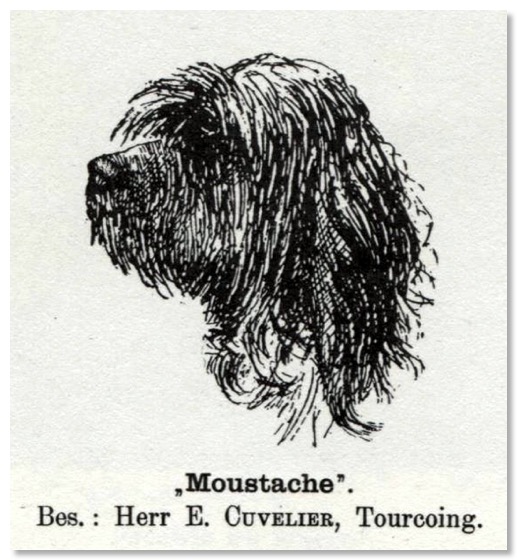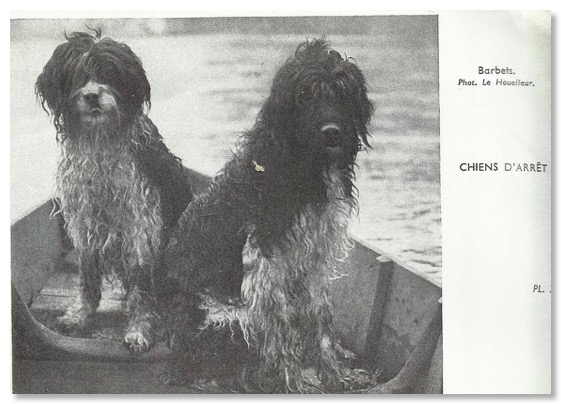January 2020
About the Barbet
26/01/20 00:07

Famous last words... about the Barbet.
It is time to fact back and bury the myths in truth, don't you think?
I think we all agree that dog history like all histories, must be based on evidence. Lore and legend are totally poisonous to our understanding of dogs, and in trying to understand where certain breeds come from, we are often confronted with the absurd, the stupid and the romantically gullible. When history suggests…it is not based on facts, but myths. The Barbet is an ancient/antique breed? It was not a breed, but a type of dog. Did people refer to the Barbet as we know it today? Not at all. My first question would be about the breed's influential history. It has not shared any past history with the PWD, SWD, Lagotto Romagnolo. The standard was not written in 1894, but in 1886 for a Gundog called Barbet d'arrêt.
Perhaps the registered SCC dogs nearly disappeared between the 2 WW, but not the breed type as we can now prove in 2020 with litters born with the proper old Griffon type. Type is genetically strong, proof being photographs of the litters which CAN be traced back to 1970 for comparison in morphology and probably further as the Griffon-Barbet has never been extinct. It was simply robbed of its identity as says his re-inventor JC Hermans, himself in no uncertain terms. The few dedicated breeders have had results that show the in-depth work that has been done to continue breeding Vieux Barbets. The results are clear. There are less than a handful in the world.
The Barbet Moderne and JC Hermans, its creator in the 1980/90's: Most written French references are about the barbet-caniche a pet dog /circus dog /shoe cleaner's assistant, small dog. Early and late cynologists agreed that the small dog was called barbet/chien cane/caniche>>poodle/pudel as marsh retriever. Etymology in different countries gives different names to waterdog breeds. Skipping around picking sources that sound impressive can be fun, but extremely misleading. Mr Hermans is famous for skipping around and using sources that do not always correspond to facts, but they attract gullible people. He has written 3 anthologies of stories about different water dog breeds but mostly about the barbet-caniche. They are far from clear as you never really know where his opinion stops and facts start.
A good Barbet's silhouette is different from the other water dogs because it does look like a Griffon. When many Barbets look like Poodles or Spanish Water dogs, how do you decide? The length of the leg?! Hermans eventually under pressure admitted that barbet was a generic word for a dog with a beard and a mustache, regardless of its size from the Bichon to the Ovcharka. The Griffons have beards and mustaches, too… but he mention them very briefly.
The major problem being that like the Caniche, the Barbet d'arrêt was NOT of French origin. When you restrict research to a particular country with borders that changed over the centuries, you can be rapidly misled. I was greatly misled with myths and when I started asking questions I was brushed away very quickly for most did not know what to say that is the reason why I decided to find information on my own and after several years I reached the conclusion that what I had been fed was the Poodle history. This was 2011. I started reading other countries' information and then information began to make more sense. I was finding the morphologies that I had seen with Mrs Pêtre's dogs and they were not Poodle ancestors. You of course know who she is... Bulletin 26 of Club du Barbet de Hermans "the Barbet de chasse " is the ancestor in Europe of the contemporary Griffons..but he does not deal with those sources in his works. He then avoids the topic. We can chitchat and blether about the breed for a long time but Jean Claude Hermans himself tells us in no uncertain terms that is re-created the Barbet. History does not suggest that the Barbet we are dealing with is the ancestor to the Poodle. Hermans does, by his writings.
When Hermans thought he could re-invent a breed and make himself known in the dog world..like Baron Korthals or Emmanuel Boulet..he planned out his specifications very carefully to little by little eradicate the old breed /Vieux Barbet/Authentic Barbet and the breeders. The Barbet he deals with is the one with historical references to..Poodles. In fact, his plan was to cross back in time to get the Barbet de Buffon, which has now been determined to be a SWD. Then, he said the Barbet was the tallest of all waterdogs, meaning his reference to an Ovcharka...and tall very curly dogs with very unmanageable coats as we see often today in France, Sweden, Switzerland and Canada. Foundation stock varies here and there and the Barbet no longer has a distinctive look. It is a ball of curls with just about anything hidden beneath the curls. A very generic dog!
How did he proceed? "When I decided to re-make the barbet, I met dogs of the Griffon-barbet type but I had to eliminate them from reproduction. James de Coninck wrote the standard of the griffon-barbet that he called barbet d'arrêt. When breeds are extinct, they are never taken off the official classification, there still existed officially a breed called barbet with a griffon-barbet standard. That is how I was able to officially modify the standard and slide it from griffon-barbet to barbet..without saying anything. At the same time the classification was modified and the new barbet was able to change groups and join its brothers from other countries. Therefore we were able to recreate the barbet thanks to the standard of another breed and thanks to the confusing appellations. The Barbet Moderne type can be traced back to famous Poodle breeders, for more than one hundred years (Wycliffe/Apiele/Eaton Affirmed).
He called on Mrs Pêtre, the daughter of the famous Mas de la Chapelle Barbet breeder of the 30's and the people who had dogs of her litters in the south of France, mostly. He solicited her to have as many litters as possible since you needed to have 50 pups born in a year to start a club. She obliged. Then he created a club, self proclaimed himself as president and got as many people to join, and slowly but surely built up his own reason for being. He found a breeder near Paris and another person willing to help find rescues in local pounds and he started crossing them and calling the results a Barbet, which he confirmed himself as he was an SCC judge. At that point dissent set in because his "product" had nothing to do with a Barbet de chasse/d'arrêt, but more of a Poodle type. He then proceeded to add Poodles despite the fact the President of the Poodle club did not want him using Poodles.. and after had a "accident" with a PWD, and went on his merry way supported by his friend.. President of the SCC.
After several litters grew and confirmation time came around, he refused as many confirmations of Mrs Pêtre dogs to get any Griffon types out of the way, eradicate the old breed and make space for his master race the Barbet Moderne he claims to have invented and his references ARE : Henri IV/Aubigné, Caius, Napoleon and Prince Rupert who had a lovely white Poodle which he kissed during debates during council meetings. An endearing pet's name could be "barbet". It just meant it was bearded... Hunting dogs were not pets. You did not carry a hunting dog in public.
About the Vieux Barbet:
If original bloodlines can trace back to 1891, I certainly would like to read that information and see some facts since I have the majority of the archives on the breed. Stop? Thug? Pilote, in the famous photograph painted by Mahler? Famous names? For the last 40 years, not many seem to ever have been involved in the old breed of Vieux Barbet or they would have had some results, by now. I see very few of the Griffon look and many poofed out dogs even as I write..Lowering the size of the dog does not mean what will be made will correspond to the standard? Why was the 1954 standard not used as a basis?
The outline should be immediately recognizable? It is. When it has a Griffon head..it is a Vieux Barbet!
Selective breeding had nothing to do with dog shows but hunting ability and many hunting dogs were never show dogs and they were working dogs. JC Hermans did not like hunting, so not referring to them was a easy task for him. In Les chiens de chasse et la théorie de la chasse, it is said that the Griffon Boulet/ griffon laineux / griffon à poil long was closer to a Barbet and the dogs existed in the north of France. The Spinone is a close relative.
Factual Griffon Barbet sources bank on Sélincourt. Fouilloux only mentions the Barbet to say it has straight legs. Febus ( the Gascon count) referred to hunting dogs, not pets. Strebel is a source of information along with references to falconry and net dogs as in Feyerabendt's book of 1582. Fleming in 1719 about dog shapes and similar families. The Roy Modus manuscript is also a well of information about hunting back in those days...1435 so yes the Barbet de chasse has a long impressive history and history has known what to make it it! The Megnin family has it in 7 diffferent volumes.
Coats do not vary in impression, but must be fit for function and the function determined. They hair fair, not fur and the strands are strong as it is a rough coated dog and not fine strands like a Poodle.
We're not talking man's best friend either but working ability of an ancient type of dog. A hunting dog is very often affable and very obedient. It is not hyper active or a barker. It can of course, be your best friend but that is not its original function. Rudolf Friess talks about long-coated hunting dogs in 1921.
The Barbet that appears in works as early as the 16th century is a barbet-caniche, as Oudry's paintings .
For our purposes the Vieux Barbet /Barbet d'arrêt: threatened with extinction is first cousin to the Griffon Boulet (now extinct and despite what JC Hermans says, the standard was recently removed from FCI databases) and was used along with it to make the Griffon Korthals as it was one of its founding fathers. (Griffon Stammbuch> GSB) A working retriever? with a standard as a gundog written in 1886 for a Barbet d'arrêt was a versatile net dog who worked on land to flush game and at the time, pointed. The Barbet as we know it today with its thick coat would drown if it had to go into water to retrieve. A dog with such thick fur can sink like a sponge in water. Who talks about work? Real gundog work and not its ability to stop draughts as said at Crufts in 2019?
As a conclusion...there are mostly myths out there to describe dog that is of recent fabrication, and for no particular function other that being an agility dog/show dog which has nothing to do with its history.
© Elaine FICHTER 2020 Reproduction forbidden without permission
